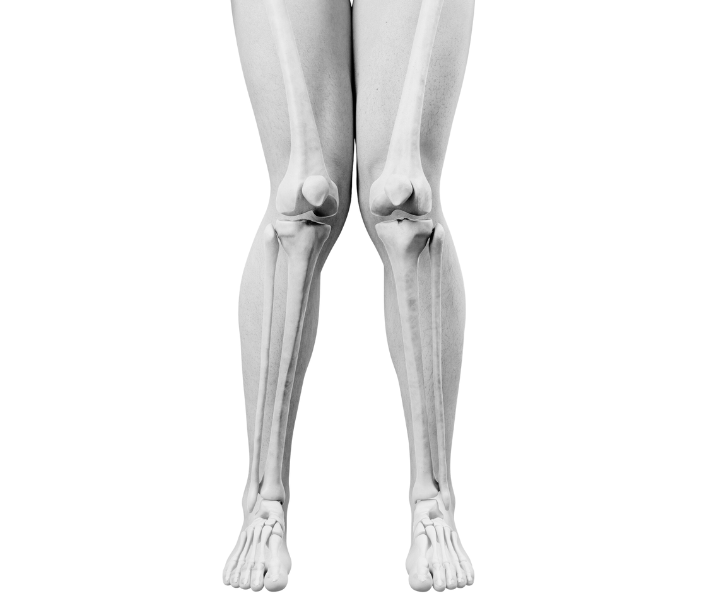What are Knock Knees
Knock knees (also known as genu valgum) refers to a condition in which a child’s knees point inward, causing the lower legs to angle outward. When a child stands with their feet together, their knees touch each other while their ankles remain apart. While mild knock knees are considered a normal part of a child’s development, more severe or persistent cases may require medical attention.

Causes of Knock Knees
- Normal growth and development: In toddlers and young children, knock knees are often a result of normal growth patterns. The legs gradually straighten out as the child grows older.
- Underlying medical conditions: Some medical conditions, such as skeletal dysplasias, rickets, or metabolic disorders, can cause abnormal bone growth and lead to knock knees.
- Family history: There may be a genetic predisposition to developing knock knees, as the condition can run in families.
- Nutritional deficiencies: In rare cases, certain vitamin deficiencies, such as vitamin D or calcium, can contribute to the development of knock knees.
- Obesity: Excess weight can place additional stress on the knees, leading to altered alignment and the development of knock knees.
Symptoms of Knock Knees
The symptoms of knock knees can vary depending on the underlying cause, but often include one of many of the below symptoms:
- Knees that touch or nearly touch each other when standing with feet together.
- Increased risk of tripping or falling.
- Visible angling of the lower legs outward.
- Difficulty walking or running with normal gait patterns.
- Changes in posture or alignment, such as tilting the pelvis forward or arching the lower back.
- Joint pain or discomfort, particularly in the knees or ankles.
- Fatigue or muscle strain in the lower limbs.
Diagnosis of Knock Knees in Podiatry
Podiatrists employ various diagnostic methods to assess and diagnose knock knees in children. These include:
- Physical examination: Your podiatrist will observe the child’s standing posture, gait, and limb alignment. They will also assess joint flexibility, muscle strength, and range of motion.
- Gait analysis: Observing the child’s walking pattern can help identify any abnormalities in foot and lower limb mechanics that may be contributing to knock knees.
- Family and medical history: Gathering information about the child’s family history, growth patterns, and any underlying medical conditions that may contribute to knock knees.
- X-rays: X-ray imaging may be ordered to assess the degree of angular deformity and evaluate the growth plates and bony structures of the legs.
Treatment Options for Knock Knees
Supportive footwear: Providing children with well-fitting shoes that offer proper arch support and stability can help promote normal foot and lower limb alignment. Your Podiatrist will be able to advise of suitable footwear for your child’s specific foot and lower biomechanic needs.
Observation: In many cases, mild knock knees in children will resolve naturally as they grow older. Regular monitoring by a podiatrist is recommended to track the child’s progress.
Orthotic devices: Custom orthotic shoe inserts may be prescribed to support the child’s feet, improve alignment, and reduce stress on the lower limbs.
Physical therapy: Your Podiatrist can prescribe targeted exercises and stretches that can help strengthen muscles, improve joint flexibility, and promote proper lower limb alignment.
Weight management: If obesity is a contributing factor to knock knees, your podiatrist may work in conjunction with other healthcare providers to develop a comprehensive weight management plan.
Bracing: In some cases, a knee brace or night splint may be recommended to provide additional support and encourage proper alignment during sleep or physical activities.
Surgical intervention: In rare cases when knock knees persist into adolescence or cause significant functional impairment, surgical intervention may be considered to correct the alignment of the legs.
Prevention of Knock Knees
To prevent or reduce the risk of Knock Knees, you should consider the following factors:
- Monitor growth and development: Regularly track your child’s growth patterns and consult a podiatrist if there are concerns about abnormal lower limb alignment.
- Promote good posture: Encourage children to sit and stand with good posture, avoiding slouching or excessive inward rotation of the legs.
- Encourage physical activity: Engage children in regular physical activities and exercises that promote strength, balance, and proper alignment of the lower limbs.
- Provide supportive footwear: Choose shoes that offer appropriate arch support, cushioning, and stability to promote proper alignment during walking and other activities.
- Promote a healthy diet: Ensure children receive a well-balanced diet that includes adequate amounts of calcium, vitamin D, and other essential nutrients for proper bone development.
- Maintain a healthy weight: Help children maintain a healthy weight to reduce the stress placed on the lower limbs.
When to See a Podiatrist
If you notice persistent or worsening knock knees in your child, or if they experience pain, difficulty walking, or other functional limitations, it is advisable to consult a podiatrist.
As a clinic that is experienced in paediatric podiatry, we regularly diagnose and treat foot and lower limb conditions in children. Early diagnosis and appropriate treatment are key to a successful recovery. Please book an appointment with one of our podiatrists for Knock Knee Treatment in Melbourne, by calling 03 9878 4566 or emailing [email protected] and we can book you in for a comprehensive assessment in the closest clinic location that suits you; Blackburn, Melbourne CBD, Newport, Caroline Springs or Springvale.
